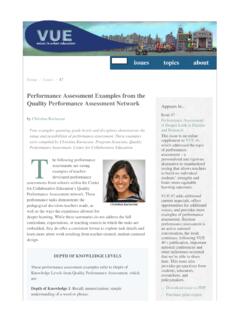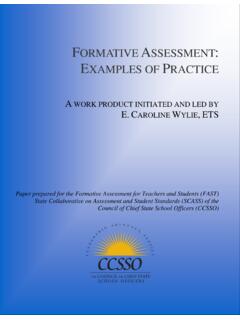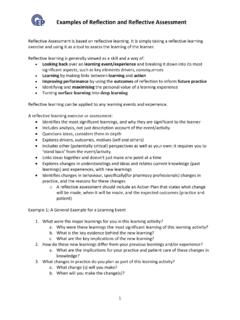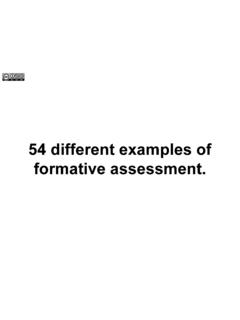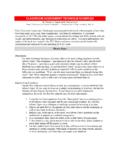Transcription of Full manual handling risk assessment: Examples of ...
1 Full manual handling risk assessment : Examples of assessment checklistsFull manual handling risk assessment : Examples of assessment checklists1 of 21 pagesHealth and Safety Executive1 A suitable and sufficient risk assessment is required when hazardous manual handling cannot be avoided. The assessment should identify where the risk of injury lies and identify appropriate ways to reduce that risk. A checklist can help with this process by helping you to systematically examine all the possible risk elements. Involving employees and safety representatives in the risk assessment process is a highly effective way of identifying hazards and developing solutions that work.
2 The Appendix in L23 manual handling includes more information on choosing the right level of detail for your manual handling risk assessment you may not need to carry out a full risk Using the checklists for lifting and carrying and for pushing and pulling will help to highlight the overall level of risk involved and identify how the job may be modified to reduce the risk of injury and make it easier to do. This will also help to prioritise the remedial actions needed. The checklists may be downloaded freely or may be used to help design your own assessment checklist . They are not interactive, but can be printed out and Work through the three sections of the appropriate checklist :Section A Preliminary Describe the task you are assessing.
3 You may also find it helpful to include diagrams or photographs to illustrate the B More detailed assessment Work through the list of factors and tick the level of risk you believe to be associated with each of the items. Note down the precise nature of the problem and include suggestions about the remedial action that may be taken. It may also help to write down the names of those you need to consult about implementing the remedial steps, eg managers, trainers, maintenance personnel or engineers and employees or their representatives. If you are assessing a lifting, carrying or team- handling operation, you can use the MAC tool ( ) to help you decide the risk levels to be entered in Section B.
4 For pushing and pulling operations, you can use the RAPP tool ( ) to help you. Some tasks may involve more than one operator, each with a different level of risk, depending on what they do. Either note the differences on one checklist or use a separate one for each operator. Return to the end of Section A and decide whether the overall risk of injury is Low, Medium or High. This will help to prioritise remedial action if you have a large number of risk assessments to carry out. Ring the appropriate word at the bottom of Section A after you have completed Section B. Section C Remedial action to be taken Summarise the remedial steps that should be taken, in order of priority.
5 Record the assessor s name, the name of the person responsible for carrying out any remedial action and the date by which it should be completed. Only complete the final column once this action has been taken. It may also be useful to enter the target date for reassessment if appropriate. 4 When all the manual handling tasks have been assessed, the completed checklists can be compared to help prioritise the most urgent actions. However, there are likely to be several ways to reduce the risks identified and some will be more effective than others. Do not delay action on those that can be implemented easily and quickly simply because they may be less effective than Check at a later date to make sure that the remedial action to remove or reduce the risk of injury has been The checklists will help bring out a range of ideas on how the risks identified can be avoided or reduced by making modifications to the load, the task, and the working environment.
6 Many suggestions for reducing risks in particular situations are given in L23 ( ). Worked Examples of risk assessments are included as well as the blank checklists to show how they might be used in manual handling risk assessment : Examples of assessment checklistsHealth and Safety Executive2 of 21 pagesAssessment checklist for lifting and carrying Section A: Preliminary Operations covered by this assessment (detailed description): Locations: Personnel involved: Date of assessment : Diagrams (other information including existing control measures): Overall assessment of the risk of injury?
7 Low/Medium/High* *Circle as appropriate Make your overall assessment after you have completed Section B. Task name:Task description: Load weight: Frequency of lift: Carry distances (if applicable): Are other manual handling tasks carried out by these operators? assessment discussed with employees/safety representatives:Is an assessment needed? (An assessment will be needed if there is a potential risk of injury, eg if the task falls outside the guidelines in the L23 Appendix.)Yes/No*If Yes continue. If No the assessment need go no further.
8 *Circle as appropriateFull manual handling risk assessment : Examples of assessment checklistsHealth and Safety Executive3 of 21 pagesSection B: Lifting and carrying More detailed assessment , where necessary Questions to consider:If Yes , tick appropriate level of risk Problems occurring from the task. (Make rough notes in this column in preparation for the possible remedial action to be taken.)Possible remedial action, eg changes that need to be made to the task, load, working environment etc. Who needs to be involved in implementing the changes?LowMed HighN/A Do the tasks involve: holding loads away from torso?
9 Twisting? stooping? reaching upwards? large vertical movement? long carrying distances? strenuous pushing or pulling? unpredictable movement of loads? repetitive handling ? insufficient rest or recovery? a work rate imposed by a process?Are the loads: heavy? bulky or unwieldy? difficult to grasp? unstable or unpredictable? intrinsically harmful (eg sharp/hot)? Health and Safety Executive4 of 21 pagesFull manual handling risk assessment : Examples of assessment checklistsSection B: Lifting and carrying More detailed assessment , where necessary Questions to consider:If Yes , tick appropriate level of risk Problems occurring from the task.
10 (Make rough notes in this column in preparation for the possible remedial action to be taken.)Possible remedial action, eg changes that need to be made to the task, load, working environment etc. Who needs to be involved in implementing the changes?LowMed HighN/AConsider the working environment Are there: constraints on posture? poor floors? variations in levels? hot/cold/humid conditions? strong air movements? poor lighting conditions? Consider individual capability Does the job: require unusual capability? pose a risk to those with a health problem or a physical or learning difficulty? pose a risk to those who are pregnant?










